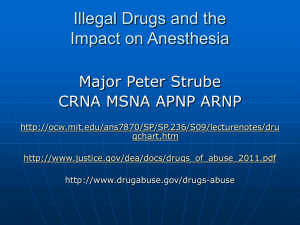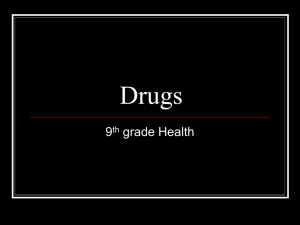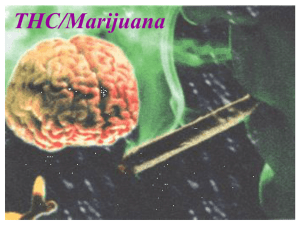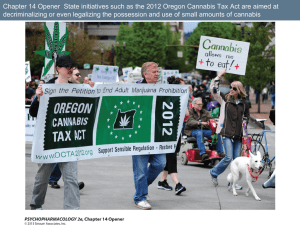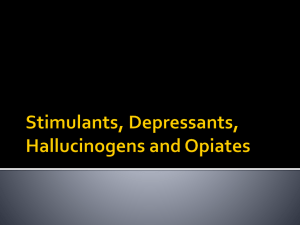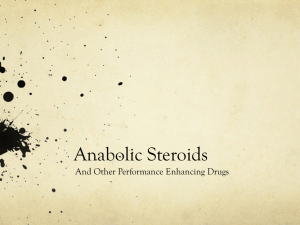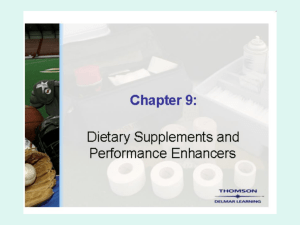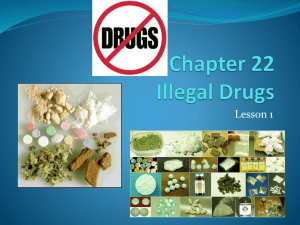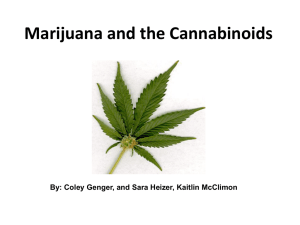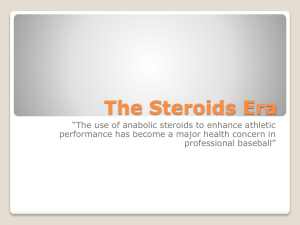Drugs & Medicines
advertisement
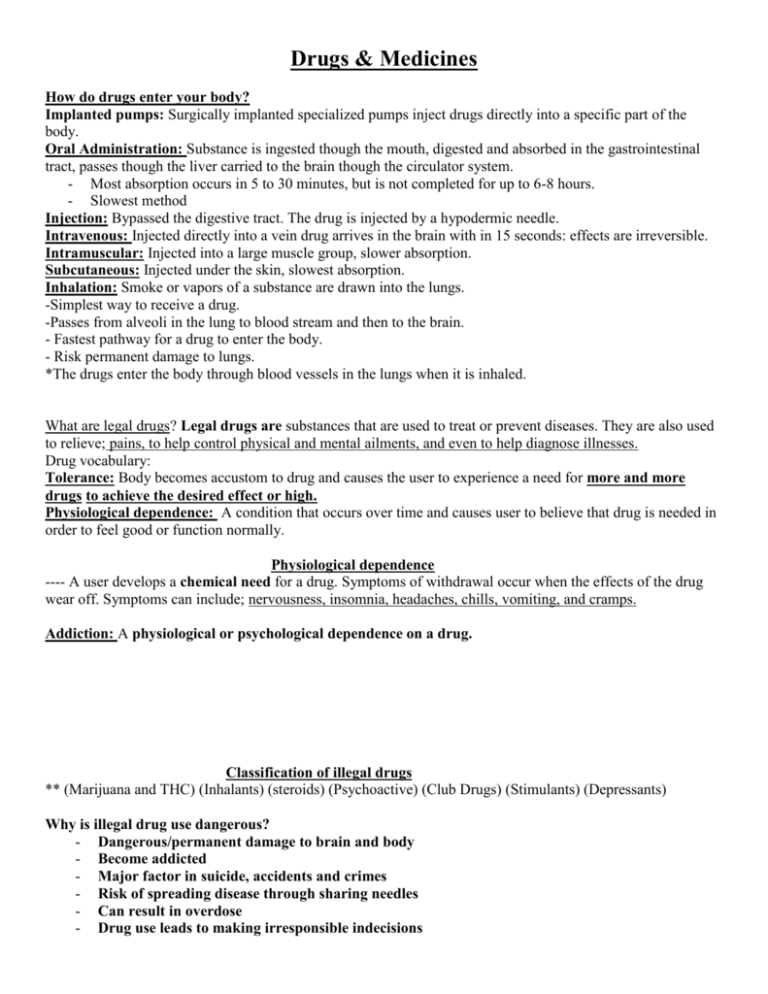
Drugs & Medicines How do drugs enter your body? Implanted pumps: Surgically implanted specialized pumps inject drugs directly into a specific part of the body. Oral Administration: Substance is ingested though the mouth, digested and absorbed in the gastrointestinal tract, passes though the liver carried to the brain though the circulator system. - Most absorption occurs in 5 to 30 minutes, but is not completed for up to 6-8 hours. - Slowest method Injection: Bypassed the digestive tract. The drug is injected by a hypodermic needle. Intravenous: Injected directly into a vein drug arrives in the brain with in 15 seconds: effects are irreversible. Intramuscular: Injected into a large muscle group, slower absorption. Subcutaneous: Injected under the skin, slowest absorption. Inhalation: Smoke or vapors of a substance are drawn into the lungs. -Simplest way to receive a drug. -Passes from alveoli in the lung to blood stream and then to the brain. - Fastest pathway for a drug to enter the body. - Risk permanent damage to lungs. *The drugs enter the body through blood vessels in the lungs when it is inhaled. What are legal drugs? Legal drugs are substances that are used to treat or prevent diseases. They are also used to relieve; pains, to help control physical and mental ailments, and even to help diagnose illnesses. Drug vocabulary: Tolerance: Body becomes accustom to drug and causes the user to experience a need for more and more drugs to achieve the desired effect or high. Physiological dependence: A condition that occurs over time and causes user to believe that drug is needed in order to feel good or function normally. Physiological dependence ---- A user develops a chemical need for a drug. Symptoms of withdrawal occur when the effects of the drug wear off. Symptoms can include; nervousness, insomnia, headaches, chills, vomiting, and cramps. Addiction: A physiological or psychological dependence on a drug. Classification of illegal drugs ** (Marijuana and THC) (Inhalants) (steroids) (Psychoactive) (Club Drugs) (Stimulants) (Depressants) Why is illegal drug use dangerous? - Dangerous/permanent damage to brain and body - Become addicted - Major factor in suicide, accidents and crimes - Risk of spreading disease through sharing needles - Can result in overdose - Drug use leads to making irresponsible indecisions The reasons people begin using drugs are similar to the reasons they begin to drink or smoke. What are these reasons? - Desire to experiment Desire to escape depression/boredom Enjoyment of risky behavior Belief that drugs solve personal problems Peer pressure Media glamorizing drug use Marijuana and THC: Marijuana is produced from the dried leaves and flowers of the Cannabis plant.++++++++ The active ingredient in THC is (tetrahydrocannabinol) ****A Fat-Soluble drug produces psychoactive effects in Marijuana. **** Fat Soluble means that the drug will be distributed to the areas of the body with high fat content. THC stays in the body for several weeks. Why? ***** Fat soluble areas of the body are: Brain, lungs, and reproductive systems. -------- A person who uses marijuana may be under its effects several days later, even though the high has worn off. Marijuana, how it’s used: Smoked, ingested, or absorption as a pill. When Smoked much more THC enters the blood stream. It is used to enter a state of calmness or Euphoria. Almost all users report a change in the way they perceive time. Larger doses may produce anxiety and feelings of paranoia. Short term effects: increased heart rate, reddening of eyes, talkativeness, and giddiness. Some users may become quiet or reactionary. (Similar to FIGHT OR FLIGHT Responses.) Marijuana and Medical uses: when made synthetically - Lessens nausea associated with Chemotherapy - Help people with AIDS regain appetite - Used to treat Glaucoma (Glaucoma is the buildup of pressure on the eyeball.) Marijuana and THC Effects on the Brain: -Increased level of dopamine (Dopamine is a hormone that produces a pleasurable feeling.) -THC works by binding to specific receptors in the barin called “Cannabinoid Receptors”; which are located throughout the following brain structures: Cerebellum Hippocampus Cerebral cCortex Limbi System. Brain: Inside of the Hippocampus THC activates cannibinoid receptors in the hippocampus. This then affects memory, by deceasing nerve cell activity in this area. Short-term memory is the first to be affected. ** THC affects areas in the cerebral cortex that are responsible for sensory perception. Example of this: Sense of taste, sight, smell, hearing, and touch may be altered. Limbic System: THC when absorbed in the body produces changes in the limbic system (governs) our emotions. These changes, which are most evident during withdrawal from THC, are similar to those observed after long term use of cocaine heroin and alcohol. Inhalants **** Inhalants are substances whose fumes are sniffed or inhaled to get effect*** Types of Inhalants: Prescribed Inhalants: used to treat allergies, asthma, and other medical conditions. Solvents: Aerosols, glues, pains, gasoline, “these if used can cause brain damage.” Inhalants Effects on the Body **Depress the central nervous system** - Immediate effects glassy stare - Slurred speech - Impaired judgment - Nausea - Coughing - Nose bleed and fatigue - Lack of coordination - “can lead to permanent loss of brain damage” Long term problems: Liver and Kidney damage, blindness, brain damage, paralysis, cardiac arrest, and death. “All inhalants are extremely dangerous; many products are labeled as poisonous and can be harmful even if you are not trying to abuse them.” –Can Be accidentally inhaled when doing household chores. Tip: “when using inhalants, work in well ventilated rooms, and wear a mask when projects require long exposure to fumes. Steroids Steroids can be prescribed for medical purposes; anabolic/ androgenic steroids: synthetic substances similar to male sex hormones. (Anabolic refers to muscle building) (Androgenic refers to increased male characteristics.) **Anabolic-Androgenic steroids: Synthetic derivatives of the natural occurring male anabolic hormones. (Testosterone) Anabolic means “to build” Androgenic means “masculinizing” ********** Steroids produce more testosterone which is the primary male hormone responsible for the development of masculine traits. Androgenic effect triggers the maturing of the male reproductive system. Anabolic effect helps body retain protein which aids in development of muscles. ANABOLIC PROPERTY LURES ATHLETES! Steroids, how it’s used? -Can be taken orally (Pill capsules) or injected (hypodermic needles) (Injected steroids are broken down into additional categories Long-lasting Short-Lasting and water soluble injections.) Who takes Steroids? -athletes, men are stereotypically associated with steroids, or anyone who desires to look, perform, or feel better regardless of danger. Health Hazards: -Transmitting or contracting HIV or Hepatitis B through needles. “Side effects can occur long after you stop using.” ****Mega-dosing: using more than one type of steroid at a time, effects can be irreversible body damage.**** Male and Female Problems with Steroids ++Physical Side effects; Male problems: -Feminization significantly decreased in normal sexual functions -Reduced sperm count and impotence -development of breasts -shrinking of testicles -Difficult or pain while urinating ++ Physical Side effects: Female problems: -Experienced masculinization effects -facial hair growth -deepened voice -breast reduction -menstrual cycle change -“steroids both genders” : acne, bloated appearance, rapid weight gain, clotting disorders, liver damage, premature heart attacks, stokes, elevated cholesterol, and weakened tendons. “Steroids Special Dangers to Adolescents” -Steroids close growth centers in young teenagers bones. Once growth plates are close they cannot open. Adolescents may end up potentially shorter than they should have been. Steroids are addictive: Long-term steroid users may experience addiction through: cravings, difficulty in stopping, withdrawal symptoms. STEROIDS DO NOT HELP IMPROVE SKILL, AGILITY, OR CARDIOVASCULAR CAPACITY. Psychoactive Drugs -Chemicals that affect the function of the central nervous system can alter brain activity. *four main groups: Hallucinogens, opiates, stimulants, depressants *****Psychoactive drugs some have medicinal value: When misused and abused an individual’s health is seriously affected. ----- Effects on a TEENS’s developing brain and body are especially damaging.****** Consequences of Psychoactive drugs: -poor judgment and behaviors -unintentional injuries -violence -STD’s -Unintended pregnancy -Suicide Hallucinogens: category of drugs that affect the brain in such a way that a person’s perceptions—meaning their sights, sounds, feelings, and how they judge time—become very different and unreal. (Can cause: changes with emotions, memory, and judgment.) LSD (hallucinogen): also known as acid, doses, trips, tabs, hits, sunshine, window pane, sugar cubes, microdot is a very powerful drug made with a chemical found in fungus—that grows on grains. History of LSD: It was originally developed as a treatment for mental patients, but doctors soon learned that it was too unpredictable to be useful. In the 1960’s many people took LSD because they believed the drug “expanded their minds.” LSD is usually found as pieces of thin paper sprayed with the drug, which are eaten or in gelatin or liquid form. LSD side effects: Changes in personality and mood +++Mood swings, hallucinations, delusions, intense fear, confused senses like seeing sounds or hearing colors. +++Dilated pupils, increased body temperature, sweating, loss of appetite, sleeplessness, dry mouth and tremors. LSD health risks: increased heart rate and blood pressure, long lasting mental problems develop such as schizophrenia, or depression. LSD problems: when using, scary hallucinations can make people panic which can lead them into dangerous situations. LSD “flashbacks” are very common with the drugs effects returning without warning from a few days to a year later. Users develop tolerance, meaning they need to use more and more to get the same effect. Opiates: Which means It comes from a flower called the opium poppy opiates are used in hospitals as pain killers for patients in serious pain from injury, surgery, or illness; morphine is another opiate used for medical purposes Heroin (Opiate) is a brown or white powder that is sometimes snorted or smoked. Most of the time, users turn it into a liquid and inject the drug into their veins with a needle. Side effects: euphoria, “a rush” of well being, reduced pain, dry mouth, droopy eyelids, smaller pupils due to vascular constrictions. Other indicators include : flush skin, heavy arms and legs, slow thinking and movement, slow and slurred speech, periods of sleepiness, sometimes called “the nod” vomiting, constipation, and considered to be THE MOST ADDICTIVE DRUG Heroin (opiates) Health Risks: Collapsed veins, heart infections, pneumonia, death from overdose Problems with using Heroin: Is one of the most physical addictive drugs in the world, breaking the addiction can be very difficult. Users develop a tolerance meaning they need more and more of the drug to get the same effect. Because heroin can be expensive, users often turn to crime to get drug money. Sharing needles can lead to infectious diseases including hepatitis and AIDS. While using: quitting the drug or “ kicking the habit” can lead to bad withdrawal symptoms including pain nausea, vomiting, direarrhea, cold flashes, and incredible craving to return to the drug. Quitting suddenly called “going cold turkey” can lead to death in long term addicts in bad health. Stimulants: are a class of drug that elevate mood, increase feeling of well being, and increase energy and alertness. **often produce a feeling of euphoria in users. -examples are: caffeine, amphetamines, methamphetamines, Cocaine Cocaine is a powerfully addictive stimulant that directly affects the brain. The pure chemical cocaine hydrochloride has been an abused substance for more than 100 years. And “coca” leaves have been ingested for thousands of years. (affects dopamine in your brain.) Pure cocaine: was first extracted from the leaf of the Erythroxylon coca bush. Which grows primarily in Peru and Bolivia. In the early 20th century, it became the main stimulant drug used in most of the tonic/elixirs that were developed to treat a wide variety of illnesses. IT was also one of the ingredients of coca-cola. How it’s used: in powder form it can be snorted or dissolved into water and injected. Crack is a cocaine that has not been neutralized by an acid to make the hydrochloride salt. This form of cocaine comes in the form of rock crystals that can be heated and it’s vapors smoked. The term ”crack’ refers to the crackling sound it makes as it cooks. Faster absorption and more intensified HIGH! Short term effects: euphoric energetic talkative, mentally alert senses, especially alert, decreased need for food or sleep, constricted blood vessels, dilated pupils, increased temperature, increased heart rate and blood pressure. Long term effects: irritability, restlessness, paranoia (lead to paranoid psychosis) the individual loses touch with reality. (Experiences auditory hallucinations.) Problems with using: dependence and addiction, Cardiovascular problems, irregular heat beat, heart attack, neurological incidents, including stroke seizures fungal brain infections. -----Pulmonary effects: such as fluid in the lungs, aggravation of asthma and other lung disorders, and other respiratory failures. -----Psychiatric complications: including psychosis, paranoia, depressions, anxiety disorders, & delusions. Cocaine problems continued… -Increased risk of traumatic injury from accidents -aggressive -violent -criminal behavior -other individual problems include: sleeplessness, sexual dysfunction, diminished sense of smell, perforated nasal septum, nausea, and headaches. (crack users often singe eyebrows or eye lashes with the flame of matches or lighter. They also burn fingertips and other body parts from contact with super heated vessels. Ie: glass pipes Cocaine problems while pregnant: Fetal cocaine effects include premature separation of placenta, spontaneous abortion, premature labor, low birth weight, small head circumference at birth, great chance of visual impairments, mental retardation, genitourinary malformations, and greater chance of developmental problems. ---For Intravenous injection: (IV) Cocaine users, there is increased risk of hepatitis, HIV infection, and endocarditis. For addicts, whether they smoke, inject, or snort, promiscuous sexual activity can increase the risk of HIV.
